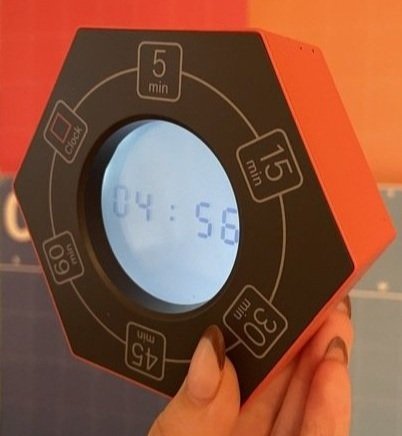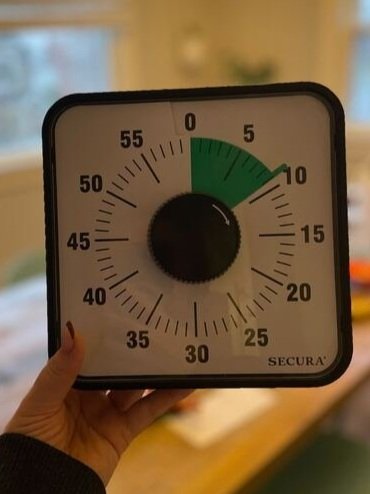How to Use Timers to Increase Productivity
Learn how to use this simple tool to encourage healthy habits and increase productivity, and find out our personal favorite timers!
As an entrepreneur-mom with ADHD, timers have become a CRUCIAL tool for maintaining my productivity. Timers make tasks much less daunting by breaking them down into smaller intervals. Whenever I find myself feeling overwhelmed or tempted to quit, I set a timer to help me reengage and find the motivation to finish or restart my tasks. If I walk into my office and feel consumed by the chaos, I will set a quick 5-minute timer and see how much tidying I can get done. It truly feels like you can accomplish ANYTHING in those 5 minutes and the time flies by. When that timer goes off you can enjoy that moment of success before deciding if you want to celebrate that win or keep working!
I also find that timers are a huge help with my kids! Timers can be a great visual tool that helps children anticipate and navigate changes. They can physically see how much time they have left in one activity and will know when it's time to move on from the sound of the timer going off. This helps tremendously in preventing potential tantrums that will throw off our day!
Pomodoro Technique
When discussing timers and using them as a tool for increased productivity, you may hear about the Pomodoro Technique. Developed by Francesco Cirillo, a university student in the late 1980s, the Pomodoro technique helps break up bigger tasks into smaller ones and makes them more manageable. Cirillo found it difficult to complete his assignments so he challenged himself to commit to a 10-minute uninterrupted study time. He found a tomato (pomodoro in Italian) timer in his kitchen and eventually wrote a book explaining the technique he had created.
The technique goes as follows:
Get a to-do list and a timer.
Set your timer for 25 minutes, and focus on a single task until the timer rings.
When your session ends, mark off one pomodoro and record what you completed.
Enjoy a five-minute break.
After four pomodoros, take a longer, more restorative 15-30 minute break.
This technique can be very effective in busting procrastination and creating motivation. Pomodoros work really well for desk work (getting through your work projects, studying, etc.). When it comes to everyday home care, self-care, and life tasks, we don’t look at it as much as a series of timed sessions, but more so as a push to start something that’s hard for you to start. When “just starting” is the goal, you can see how you can boost productivity in all the spaces of your home and life.
How to Build Habits Using Timers: Incorporating Timers into a Research-Backed Habit-Building Technique
Now consider how you can incorporate using timers into your daily routine! At Shelpful, we like to use the Tiny Habits method when starting new habits. Dr. BJ Fogg, a world-renowned habit coach, and brain behind tiny habits explains that habits should be made as tiny and simple as possible and anchored to an already existing trigger throughout your day.
Anchor (existing habit) + Tiny Habit (a miniature version of your new habit)
This ends up looking like this: “After I ___, I will ____.” So for example, if you are wanting to tidy up your office in the mornings, you may design a habit like this: “After I turn on the light switch in my office, I will turn on a 5-minute timer.”
By using this habit-building method, you are establishing a “home” for your new habit alongside an existing habit, which makes it less taxing on your brain. It doesn’t need to build a whole new neural network for the habit. It can just glide from one thing (like turning on a light switch) to a new tiny habit (like turning on a timer) When we make it easy, and focus on the initiation of the habit, it’s more likely to become second nature. There are so many ways to create habits with timers, but using this habit equation is a great way to start!
5 Examples of Tiny Habits that Use Timers:
After I walk up to the sink in the morning, I will set a 5-minute timer (tidy up any leftover dishes from the night before).
After I turn on the light in my office, I will set a 5-minute timer (to tidy up and reset my space)
After I close my computer for the day, I will set a 20-minute timer (get a quick workout or mindfulness activity out of the way before starting your evening wind-down routine).
After I step out of bed, I will set a 10-minute timer (see how much of your routine you can get done before getting consumed by your phone, this can help with mindfulness too!)
One VERY important thing to note here is that turning the timer on is the WHOLE habit. Yes, you are working on this timer habit because there’s a bigger thing you want to do. But we want to train the brain on the initiation of the habit. In this case, turning on the timer. Once you turn on the timer, you should SMILE or do a little jump for joy. You did the habit! Then, hopefully, you tidy or exercise, or do the thing. But just turning the timer on should be celebrated. If you are seeing you consistently only set the timer, and don’t do the actual activity, then you can revisit the design of your habit, or talk to one of our Habit Coaches for a free 30-minute call.
Using Music as a timer to get things done
Maybe timers aren’t your thing, whether you don’t want to order another thing off Amazon, or the beeping at the end drives you insane. Lucky for you, we have the perfect solution! Pick a song or two and see how much you can get done before it ends, while also jamming out to your favorite songs!
When choosing a song or two to get productive, consider its length. Find one roughly around the time you would set a timer to, or find a couple of songs that would be equivalent. Choose songs that will motivate you to be productive, ones that you can sing along to but won’t get distracted from your task at hand. The higher the BPM of a song, the better, you want to “race to the rhythm” as this Cleanipedia article puts it so brilliantly.
Some of our favorite songs to use:
“All Too Well (10-minute version)” Taylor Swift
“Bohemium Rhapsody” Queen
“Crazy in Love” Beyonce
“Rock Your Body” Justin Timberlake
“Dancing Queen” Abba
“Mr. Brightside” The Killers
“I wanna dance with somebody” Whitney Houston
“Don’t Stop Believing” Journey
“Just Dance” Lady Gaga
“Uptown Funk” Bruno Mars
“Happy” Pharrell Williams
“Party in the U.S.A.” Miley Cyrus
“Firework” Katy Perry
“Sugar” Maroon Five
“I Gotta Feeling” Black Eyed Peas
Check out this Spotify playlist filled with our favorite songs to increase productivity!
The Best Timers for Productivity
These timers are great for everyday productivity and for the pomodoro technique.
Timers are a huge tool in my life so I’ve tried a LOT of them, these are my favorites that I use every day!
It's a clock too! We use this for mono-tasking, flip it on for 15 minutes and see how much of ONE thing you can get done!
It's tiny so it fits perfectly in “habit start spots.” We use it for the habit: “after I walk into my office, I’ll turn the timer to 5 minutes.” It’s great for seeing how much tidying you can get done in the first 5 minutes of walking into the office.
Great for time blindness and easy to just crank to any amount of time without thinking too much.
Coming in at a whopping 7.5 inches this is an excellent visual timer. It's great for helping kids with screen time cutoffs or “we are leaving in 10 minutes” so they are able to learn time management. Put it up high so they can’t mess with its still visible with the size!
Oven timer
For kitchen habits, you are often surrounded by timers, so use ‘em!
Apple Watch / Smartphone timers, of course!
I use my apple watch to set timers in places where I don’t have a visual timer. It doesn’t work as well for me, because if I can’t see it counting down, I don’t feel quite as driven. But it does work in a pinch!
No matter what timer you choose, making the effort to allocate time to a new good habit for you is a step in the right direction. If you try out the timer method but still aren’t checking all the boxes on your to-do list, it’s ok to ask for help. The real-human buddies at Shelpful help their members with sticking to their daily goals with reminders and celebrating even the smallest wins! They can also ask you to start a timer, and follow up to make sure you did it!
If you want to dive even deeper into the world of habit building we highly recommend checking out habit books like Tiny Habits or doing a 90-min workshop to learn the methodology.
Let us know how you incorporate timers into your life! Message or tag us on Instagram / Tik Tok.




